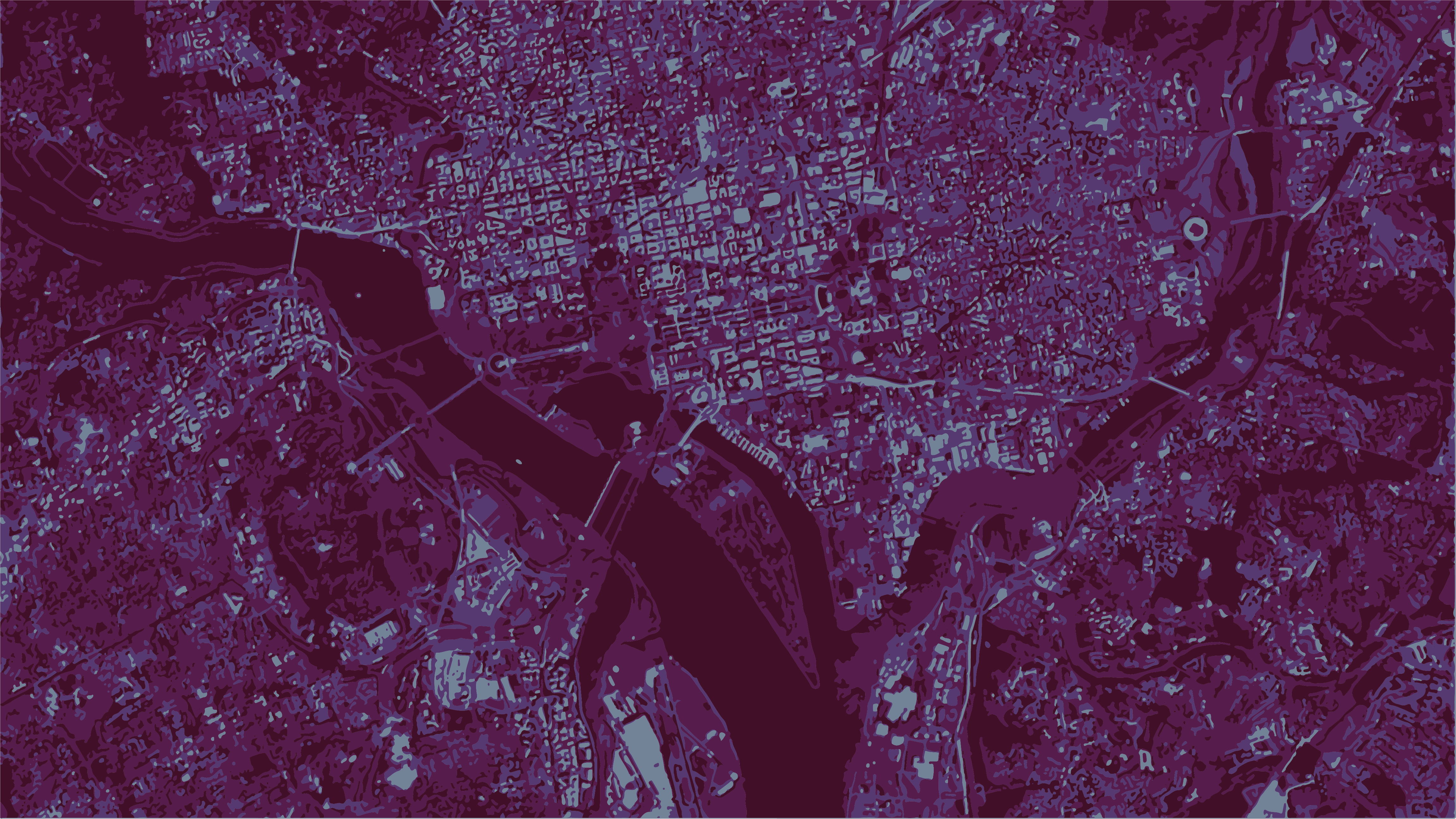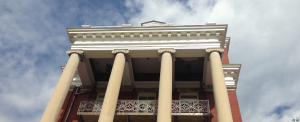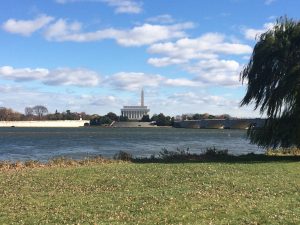To understand D.C.’s relationship with climate change, looking at the District’s latest climate resilience plan is the place to start. When D.C. Mayor Muriel Bowser released a lengthy policy roadmap in April 2019, she laid out four large goals which, in addition to environmental action, include promoting inclusive population growth, safer and healthier Washingtonians, and smart implementation of technological advancement.
While the plan does specifically address economic and racial inequality, it fails to lay out a path that will create an inclusive D.C. in the face of environmental crisis. The plan is rife with evidence that the District’s leaders haven’t listened to their most vulnerable populations; it ignores racialized zoning, neglects necessary Metrorail expansion, and leaves problems of inequitably distributed green buildings and green space unaddressed. Moreover, far from pushing toward racial justice, the climate resilience plan aims to expand policing in the city, a move directly harmful to residents of color.
American University professor Malini Ranganathan, who researches environmental racism, critiques the notion of “resilience” that the plan depends on. She argues that focusing on recovering from disruptive crises ignores the political origins of problems that make certain communities vulnerable in the first place. Instead, Ranganathan asserts that elevating marginalized groups through abolitionist climate justice—which prioritizes “history, intersectional experiences, and forms of care, healing, and solidarity”—is more appropriate.
In order to truly achieve climate justice, D.C. must center economic inclusion and racial justice in its climate policies. To that end, policymakers must address a legacy of environmental racism that continues to harm Black communities. They should expand the city’s provision of sustainable public services rather than expecting individuals to make sustainable choices themselves, since individual sustainability isn’t affordable, especially for working-class people. The best way to actually achieve these goals is to make climate action local: Amplify the voices of local neighborhoods and their representatives, especially in communities with marginalized or working-class populations.
Tomorrow’s forecast
In 30 years, rising sea levels will place huge swathes of D.C at risk of flooding during increasingly frequent and severe storms. The city will also face two to three times as many “heat emergencies”—days above 95 degrees fahrenheit.
These increased risks, however, won’t be distributed equally across the city. Due to government redlining and housing discrimination, Black residents have been priced into neighborhoods in Eastern D.C., which are more at risk of flooding due to the proximity to the Anacostia River. Many industrially zoned neighborhoods in northeast and southeast D.C., which lack green spaces, are projected to become considerably hotter than whiter, wealthier, non-industrial neighborhoods in the west of the city.
These changes will disproportionately harm those without economic resources. People experiencing homelessness are particularly vulnerable to heat and flooding, since they often lack access to long-term accommodations or even air-conditioned shelters. Even people with stable housing need income to ensure that their houses can remain cool and protected from inclement weather. The ability to adapt to climate change is thus directly linked to economic inequalities, which systemic racism exacerbates. It is unacceptable that D.C.’s climate plan refuses to adequately address this reality.
The particulate details of environmental racism
The visible pollution around us—from industrial sites, bus terminals, construction facilities, and landfills—disproportionately harms people of color. Polluting industrial and waste management sites are often built in poorer, less-white communities, leaving residents with lower qualities of life and long-term health consequences.
D.C. is itself a case study in environmental racism. Almost half of the District’s industrial zones lie within Ward 5, a majority-Black area of the city that hosts recycling centers, the D.C. garbage truck fleet, construction companies, and asphalt paving companies. On top of these existing polluters, and despite the fact that bus exhaust is the most toxic kind of vehicle emission, the D.C. government is moving ahead with plans to build a gigantic bus terminal for the city’s school buses in Ward 5.
This industrial variant of environmental racism exposes D.C.’s nonwhite communities to significantly higher rates of asthma, respiratory illness, and lung disease—and puts them at higher risk of hospitalization for COVID-19.
Additionally, three of the District’s five waste transfer stations are clustered in the Ward 5 neighborhood of Brentwood, which is 85 percent Black. The city’s two other waste transfer stations sit in Fort Totten and Benning Road, also majority-Black neighborhoods. These stations attract disease vectors such as seagulls and rats, require diesel-fueled garbage trucks, and emit airborne mercury pollution.
Though these risks have been abundantly clear for some time, D.C. has denied Ward 5 representatives’ requests for an environmental impact assessment. In contrast, when Brentwood was a white neighborhood before World War II, it received far more protections from pollution and industrial zoning. The role of systemic racism in enforcing environmental disparities is undisputable—while D.C.’s zoning laws force increased health risks and a decreased standard of living onto Brentwood residents, homeowners in majority-white Ward 1 and Ward 2 get their trash collected twice a week while having zero waste transfer stations in their vicinity.
Industrial zoning artificially depresses residential property values, too, lowering private incentives to invest in making these communities better, or greener, places to live. And not a word in the climate resilience plan aims to change that.
A public transit away from roads
Transit is a huge piece of the environmental puzzle—and here, the plan fails, too. The public transit system’s failure to adequately serve lower-income and majority-Black communities increases travel times and emissions unequally across the city. Because newer cars with better fuel efficiency ratings are more expensive, lower-income drivers with older vehicles will emit more on average than richer drivers will—especially when they commute from distant neighborhoods.
The D.C. government has exacerbated this disparity in emissions by gutting its public transit services over the past decade. Incremental privatization of various transit options, including MetroAccess Paratransit, which drives disabled residents to Metro stations or bus stops, has led to service cuts in low-income neighborhoods and communities of color. A failed 2016 plan to reduce Metrorail service during peak hours included a map where more than half of the stations on the chopping block fell east of the Anacostia River, where most residents are Black and lower-income. Likewise, proposed cuts to 30 Metrobus routes in 2017 would have disproportionately hurt low-income workers of color in North Virginia. D.C. policymakers have forced the burden of public transit cuts onto the city’s most vulnerable, so it’s no surprise that DMV residents haven’t ditched their cars.
The District’s climate resilience plan acknowledges that the city’s residents deserve better public transit options. To its credit, the plan aims to improve and subsidize Metrobus services and invest in bicycling infrastructure, both of which are useful improvements. But the plan demonstrates a strange affinity for keeping people on roads. It calls for partnerships with private ride-sharing services, and even pledges to create “mobility corridors” for ride-shares and scooters. Not only are electric scooters significantly worse for city life and public safety than bicycles are, but subsidizing ride-sharing also increases the number of cars. The plan entirely ignores the single best way to improve transit outcomes across the entire DMV region: expanding and subsidizing the use of Metrorail.
Regional public transit already leaves many behind, not to mention late to work on their commutes from working-class DMV neighborhoods to the affluent city center. Over longer distances, buses and bicycles won’t go anywhere as far as an expanded Metrorail service can. A commitment to more frequent, reliable underground transportation provides D.C. residents faster and safer commutes, economic development around stations, and steady jobs. Metrorail improvements will benefit everybody. The fact that D.C.’s climate resilience plan ignores this reality demonstrates how the city’s privileged interests—“Big Scooter” among them, strangely enough—have captured decision making.
Building inequality
A city that doesn’t center the needs of its most vulnerable becomes a city segregated by peoples’ abilities to pay for greener surroundings.
D.C.’s climate resilience plan advises that all new buildings should be able to withstand possible climate catastrophe. But this advice is unlikely to benefit neighborhoods with lower property values which, possibly due to inadequate public transit and discriminatory industrial zoning, likely won’t see much new construction.
Moreover, every single one of the ten most “green” buildings in the U.S. Green Building Council’s 2019 D.C. rankings was located west of Union Station and south of Adams Morgan—some of the richest urban areas of the city. The neighborhoods in D.C. that are gentrifying rapidly have the money to build in environmentally friendly ways that other communities cannot secure investment for.
Green space should be evenly dispersed across the District’s neighborhoods without leading to increased living costs. West of the Anacostia River, gentrifying apartments and considerable green space fill the Navy Yard neighborhood. East of the Anacostia River, majority-Black neighborhoods have hardly any green space to speak of. The lack of green space is itself environmental racism against Black people.
Having green space isn’t just for show: Higher concentrations of trees in a neighborhood can significantly lower temperatures on hot days. Residents of neighborhoods without green space will suffer more heat-related ailments—especially the city’s unhoused residents, who will have to suffer them outside.
The resilience plan advocates for investment into green space that helps eliminate these so-called “heat islands.” But it does so by pointlessly suggesting the implementation of smaller-scale solutions such as green roofs or investing in “drinking water,” with little clarification on what that actually entails. Though the plan hints that majority-Black and low-income neighborhoods are more likely to be heat islands, the reason they’re heat islands in the first place—the concrete architecture that comes with industrial zoning—go unmentioned. Unless these investments in green space and cooler cities come with changes to zoning laws and funding for green infrastructure, this plan may be doomed to ineffectiveness.
Climate crises not only expose the District’s economic inequalities, but they also highlight how policymakers have refused to consider the needs of the city’s most vulnerable. Green space is a band-aid solution to what’s really a problem of political neglect.
Sustaining injustice
D.C. leaders’ skin-deep commitment to environmentalism not only conveniently sidesteps pressing issues of climate and racial justice but also actively makes some worse. For example, D.C.’s Department of Transportation uses “tree-clearing” as an excuse to evict unhoused people from encampments. The needs of some of the city’s most vulnerable were apparently in conflict with the alleged health of its trees; here, the city’s leaders chose the trees.
The District’s resilience plan similarly furthers injustice under the guise of sustainability. For example, the plan commits to keeping 4,000 police officers on the streets but promises that new officers won’t use cars. As part of the plan’s goal of “Safe and Healthy Washingtonians,” it actually calls for an additional 200 police officers to engage in “community policing on foot, bike, Segway, and scooter.” While the plan is quick to discuss racial disparities elsewhere, it makes no mention of D.C.’s racist policing history.
Bikes and scooters make police more mobile within limited green spaces, further facilitating the eviction of unhoused people from community land. Police often use bikes to harm people of color more generally, as seen through MPD’s kettling of Black Lives Matter protesters last summer. The “greenification” of police forces avoids the actual problems of policing itself, preventing the plan from achieving the racial justice and economic inclusion it purports to create. The fact that policing is part of a climate plan in the first place evidences how policymakers who don’t center the experiences of the vulnerable won’t connect environmental justice with racial justice.
Climate resilience requires justice
Perpetuating racism in the name of performative environmentalism is unacceptable. Above are four instances in which the resilience plan abjectly fails to adequately serve D.C.’s most vulnerable. If policymakers have already overlooked these problems in a plan that claims to pay specific attention to structural racism and exclusion, it’s likely that the plan’s execution will also produce inequalities, even with the best of intentions.
The recommendations offered in this editorial will tangibly benefit the city’s vulnerable and marginalized communities. Obviously, these recommendations can’t solve climate change—to be sure, there are many problems related to these issues that this editorial does not address. For example, food insecurity will only worsen as climate change disrupts food production, and gentrification will be exacerbated by climate disasters as property values fall for areas at risk of climate disaster and rise in greener, safer parts of the city.
The solutions to all these problems share a common starting point: D.C.’s policymakers must recognize that racial justice, economic justice, and climate justice are intertwined. If the District’s existing economic challenges make anything clear, it’s that the city needs better bottom-up governance. Neighborhood commissioners and local leaders like those in Brentwood know what their communities need to survive and thrive. Not only do D.C.’s leaders need to listen to the city’s most marginalized, but they must provide them with the resources real resilience requires.





